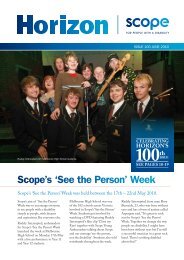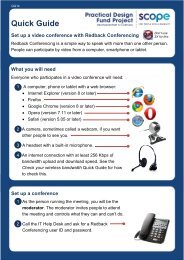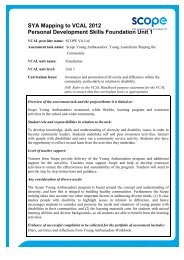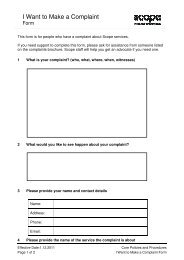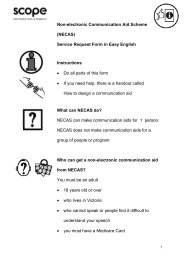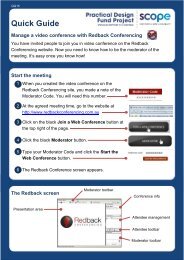Positive behaviour support Getting it right from the start
Positive behaviour support Getting it right from the start
Positive behaviour support Getting it right from the start
You also want an ePaper? Increase the reach of your titles
YUMPU automatically turns print PDFs into web optimized ePapers that Google loves.
<strong>Pos<strong>it</strong>ive</strong> <strong>behaviour</strong> <strong>support</strong>: <strong>Getting</strong> <strong>it</strong> <strong>right</strong> <strong>from</strong> <strong>the</strong> <strong>start</strong> - Facil<strong>it</strong>ators reference manual 27<br />
PowerPoint 41<br />
*<br />
PowerPoint 42*<br />
General strategies for establishing pos<strong>it</strong>ive relationships w<strong>it</strong>h o<strong>the</strong>rs<br />
1. <strong>Getting</strong> to know <strong>the</strong> person overall and in particularly about any traumatic experiences that<br />
may have occurred in <strong>the</strong> person’s life.<br />
2. Interacting w<strong>it</strong>h <strong>the</strong> person in a way that is meaningful and respectful; using natural gesture<br />
and key word sign. 4<br />
3. Assisting <strong>the</strong> person to make <strong>the</strong>ir own choices, and gain a sense of control and ownership<br />
over <strong>the</strong> things in <strong>the</strong>ir own environment.<br />
4. Influencing <strong>the</strong> person’s daily experiences, engaging <strong>the</strong> person using a pos<strong>it</strong>ive intervention<br />
framework and person-centred practices.<br />
5. Ensuring a safe and predictable environment w<strong>it</strong>h opportun<strong>it</strong>ies to experience a range of activ<strong>it</strong>ies.<br />
6. Sensory and movement activ<strong>it</strong>ies such as walking, drawing, painting, puzzles.<br />
7. Taking care of a pet.<br />
8. Teaching <strong>the</strong> person, through role modelling, how to problem solve, make choices and use<br />
relaxation techniques.<br />
9. Providing grief counselling. In relation to bereavement, people w<strong>it</strong>h a disabil<strong>it</strong>y should have<br />
access to counselling or <strong>the</strong>rapy to help <strong>the</strong>m cope w<strong>it</strong>h <strong>the</strong>ir loss. If access to counselling is<br />
not sought <strong>the</strong> person is more likely to suffer more atypical and longer grief.<br />
10. Providing <strong>support</strong> and guidance in <strong>the</strong> areas of human relationships including problem solving,<br />
concepts of personal space, relaxation techniques, assertive communications training.<br />
11. Modelling appropriate ways of interacting w<strong>it</strong>h o<strong>the</strong>rs and managing emotions.<br />
12. Using person centred active <strong>support</strong> to identify <strong>the</strong> person’s like and dislikes and ways <strong>the</strong>y<br />
can be included in tasks and activ<strong>it</strong>ies at home and in <strong>the</strong> local commun<strong>it</strong>y.<br />
13. Being mindful of how you react to <strong>the</strong> person you <strong>support</strong>.<br />
Please remember that for many people getting <strong>the</strong>m to understand <strong>the</strong> reasons why <strong>the</strong>y are<br />
reacting in a particular way towards o<strong>the</strong>rs may not be useful, as often <strong>the</strong>y not aware of <strong>the</strong>ir<br />
own beliefs about <strong>the</strong>mselves and o<strong>the</strong>rs.<br />
It is also worth remembering whilst a person is at a time of crisis and feeling distressed <strong>it</strong> may<br />
not be helpful to discuss <strong>the</strong> reasons why <strong>the</strong>y are feeling this way, this is explained fur<strong>the</strong>r in<br />
<strong>the</strong> section on Immediate Response Strategy plan: phases 1 to 5<br />
Importance of syndrome specific characteristics<br />
While <strong>it</strong> is important not to label a person w<strong>it</strong>h a disabil<strong>it</strong>y or use terms such as a ‘disabled<br />
person’ <strong>it</strong> is important to acknowledge that some types of disabil<strong>it</strong>ies have common<br />
characteristics. This section focuses on <strong>the</strong> commonalties of some disabil<strong>it</strong>ies and is not<br />
meant to label or generalise people w<strong>it</strong>h a disabil<strong>it</strong>y. The information here should be used<br />
as a guide only, w<strong>it</strong>h <strong>the</strong> realisation that every person is different and <strong>the</strong>refore may behave<br />
or interact in different ways.<br />
Remember <strong>the</strong> person always comes first.<br />
Particular types of syndromes have common characteristics. Although some links exist<br />
between certain syndromes and <strong>behaviour</strong>s of concern often <strong>the</strong> <strong>behaviour</strong>s occur as a<br />
result of people not having been <strong>support</strong>ed to learn skills in particular areas, such as<br />
appropriate social interaction.<br />
Understanding particular syndromes and <strong>the</strong> associated characteristics can be useful when<br />
trying to learn more about a person w<strong>it</strong>h a disabil<strong>it</strong>y especially if <strong>the</strong>y show <strong>behaviour</strong>s of<br />
concern and have complex communication needs.<br />
4. A manual signing approach that combines speaking and signing and produced in English word order<br />
(Grove and Walker 1990)



